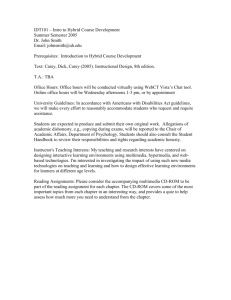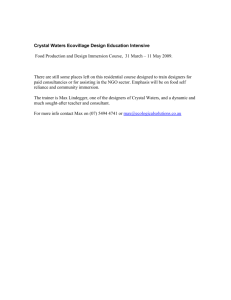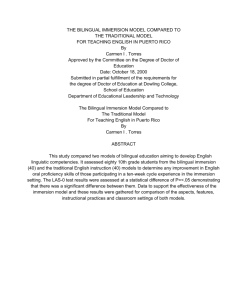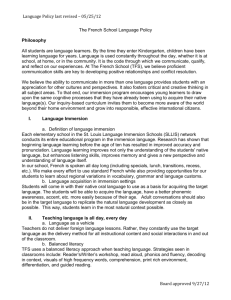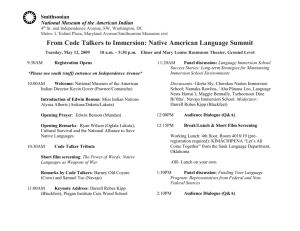11- GT2Stephen Carey~doc - Conseil Québécois de la Formation à
advertisement
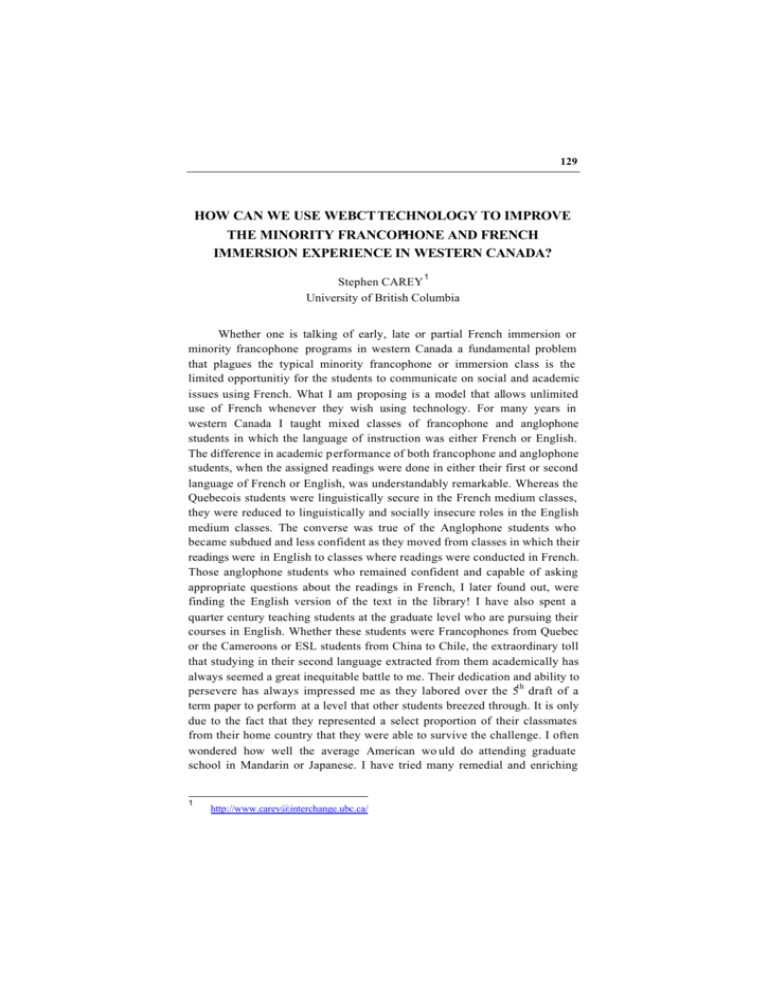
129 HOW CAN WE USE WEBCT TECHNOLOGY TO IMPROVE THE MINORITY FRANCOPHONE AND FRENCH IMMERSION EXPERIENCE IN WESTERN CANADA? 1 Stephen CAREY University of British Columbia Whether one is talking of early, late or partial French immersion or minority francophone programs in western Canada a fundamental problem that plagues the typical minority francophone or immersion class is the limited opportunitiy for the students to communicate on social and academic issues using French. What I am proposing is a model that allows unlimited use of French whenever they wish using technology. For many years in western Canada I taught mixed classes of francophone and anglophone students in which the language of instruction was either French or English. The difference in academic performance of both francophone and anglophone students, when the assigned readings were done in either their first or second language of French or English, was understandably remarkable. Whereas the Quebecois students were linguistically secure in the French medium classes, they were reduced to linguistically and socially insecure roles in the English medium classes. The converse was true of the Anglophone students who became subdued and less confident as they moved from classes in which their readings were in English to classes where readings were conducted in French. Those anglophone students who remained confident and capable of asking appropriate questions about the readings in French, I later found out, were finding the English version of the text in the library! I have also spent a quarter century teaching students at the graduate level who are pursuing their courses in English. Whether these students were Francophones from Quebec or the Cameroons or ESL students from China to Chile, the extraordinary toll that studying in their second language extracted from them academically has always seemed a great inequitable battle to me. Their dedication and ability to persevere has always impressed me as they labored over the 5th draft of a term paper to perform at a level that other students breezed through. It is only due to the fact that they represented a select proportion of their classmates from their home country that they were able to survive the challenge. I often wondered how well the average American wo uld do attending graduate school in Mandarin or Japanese. I have tried many remedial and enriching 1 http://www.carey@interchange.ubc.ca/ 130 REVUE DU CONSEIL QUÉBÉCOIS DE LA FORMATI ON À DISTANCE excercises to help these students master academic English but, while each helped, none were powerful enough to make a noticeable difference. THE BREAKTHROUGH TO VIRTUALLY CREATED E-MMERSION When WebCT was announced at UBC in 1996, it was not immediately embraced by my Department or Faculty. Nevertheless in 1996, the first course in which I adopted it proved highly successful in alleviating some of these issues of teaching second language through content education (Carey & Crittenden, 1997). Those initial results while drawing little attention among my colleagues were electrifying to me because they offered the potential for a solution to the second language problem of studying through a second language. This was due to the realization that while the principles behind immersion programs were insightful in promoting the students opportunity to use the language to communicate in, there were few opportunities to implement this principle because students did not have sufficient opportunity to develop their constructive use of the language to the point where they could engage in meaningful communication. Without the opportunity to construct meaningful communication and without the time to develop these skills, immersion programs denied the very essence of their rationale. Moreover, even if the teacher allowed the students to construct authentic oral communication this would only allow for each student a maximum of 2 minutes of communication per hour in a class of 30 students if the teacher said nothing. Minority francophone school and university French programs suffer from the same fate in that the language is often confined to school usage. WebCT now provided a means to extend the use of French far beyond the school and university. As documented in those original studies, it was clear that students using WebCT could really have ownership of their learning and they could communicate with who they wanted, about what they wanted and when they wanted. They could finally engage in critical thinking freed from the time constraints of a F/F classroom. This constituted a major change from even the best of my graduate seminars where in spite of my ability to have the students engaged in debating issues of great importance, not all students could simultaneously engage in the debate due to their limited French or English ability nor honestly say that the particular topic was their top priority. As much as those seminars had been successful in promoting critical thinking, the electronic bulletin board provided the possibility for an ongoing seminar HOW CAN WE USE WEBCT TECHNOLOGY TO IMPRO VE… 131 wherein each student debated with the student of their choice on the topic of primary interest while being unfettered by the need to perform in front of the seminar group in an instantaneous manner. ONLINE PEER CORRECTION Because there are native speakers of the target language (French, English) in both my F/F or online courses, there is always the potential for peer correction of students communicating in their second language. Furthermore, apart from the fact that peer correction may be more flexible and valued by students than instructor correction, it is also instructive to compare F/F correction with online correction. In a typical F/F seminar, it is unlikely the students who are most in need of improving their academic English are likely to participate in discussion to any great degree. This is because their lower proficiency precludes them from fully comprehending the message and also precludes them from constructing a response quickly enough to make an oral contribution. It is not atypical for such students to rarely make contributions to the discussion thus furthering their slower rate of mastery of the content and language. Thus even in my most successful seminars where I am able to manoeuvre the discussion to a topic about which the majority of the students are highly motivated to discuss, these more reticent students are not a party to the process. Moreover, if they do venture forth to join the discussion, their of necessity hastily constructed message is frequently not understood by some of the class, thus leading to confusion, embarrassment and a lower probability that they will contribute again. Furthermore, it is not easy or appropriate to correct their message or to try and decipher what they are attempting to express. Conversely, the asynchronous bulletin board allows greater opportunity for message construction (Carey-Grant Model) and also allows the respondents to creatively give peer feedback in the forms of appropriate recastings of the posted message. In several of these seminars, we have actively considered the level of academic expression or critical thinking in which we should conduct the bulletin board and have also deliberated on the best forms of peer feedback that would be highly useful and would also not be an onerous task for the native speakers. These debates have centred on how each member brings different knowledge to the discussion and just as the students from Ch ina provide us with important resources and perspectives on Asia-Pacific narratives so native speakers can seek clarification through recasts of posted 132 REVUE DU CONSEIL QUÉBÉCOIS DE LA FORMATI ON À DISTANCE messages that may aid the ESL student. Finally, because of the asynchronous nature of the BB, students messages are far less error prone due to the unlimited time for constructing their messages. As simple as this may sound, it is the first time in history that students can engage in an extended open ended asynchronous discussion following individual threads of critical thinking that are created by the student. Telephone conferencing or video-conferencing suffers by comparison from limitations of both synchronous discussion and single speaker and single topic at any one time. The importance of asynchronicity of the BB must be recognized. The simple fact that anyone can communicate to anyone and/or any group of the class at anytime and take unlimited time to compose and post any question is a fact that should be fully appreciated for providing optimal second language acquisition. CAREFUL PLANNING It must be emphasized that for the asynchronous character of the BB to fulfill its potential in promoting content and language acquisition, several factors should be firmly in place. There is nothing magical about the BB if students are not introduced to its value in an appropriate setting. For example, I used the BB as a supplement to a course attended by Japanese year-abroad students to permit them to practice their English through exploring their course content. In this case there were no course marks for activities on the BB. Consequently, these students chose to discuss the course content in Japanese and to talk to Anglophones who were prevalent on the campus. From their perspective this was an optimal way to improve their English and master course content since there were no marks for participation on the BB and they preferred to talk live with prevalent Anglophones. Their avoidance of the BB in this setting it is not entirely surprising and entirely appropriate given the availability of native speakers in the target language. Even in courses where marks are given for BB usage, its activation may take some encouragement for first time users. However when properly organized students were highly appreciative of the BB and claimed it was extremely effective for acquiring academic usage of their second language and for acquisition of course content. Both native speakers and second language students found that they gained considerable acquisition of academic vocabulary and idiom through the teaching of content on the BB. HOW CAN WE USE WEBCT TECHNOLOGY TO IMPRO VE… 133 Thus while the principles of immersion developed by social learning psychologists which stressed acquiring language incidentally through the teaching of content remain impressive in improving the levels of second language that can be attained over conventional second language courses, publications show that many of the original popular optimistic results of French immersion were perhaps unrealistic. On this theme, Cummins, 2000 writes that : « Most grade 1 and 2 French immersion students are still incapable of carrying on even an elementary conversation in French without major errors and insertions of English. To claim that two years of immersion in French, in kindergarden and grade 1, results in almost native-like proficiency in French in a context where there is virtually no French exposure in the environment or in school outside the classroom flies in the face of massive amounts of research data. » As noted above, my own research shows that this difference between abilities in French and English remains at all grade levels until grade 12 in reading comprehension and this is in spite of the fact that approximately 75 % of immersion students starting in elementary leave the program for a variety of reasons, including academic difficulties. It would not be unreasonable to postulate that the more select students stay on yielding a very biased sample of students. Why this reality is so important to note is that French immersion programs certainly produce more Fre nch competence than traditional French as a second language programs. Yet even in the enriched French immersion program the performance of these select students never attains a level near their first language comprehension and production. Understanding why immersion students are able to survive academically is extremely important if we are to conceive of ways to further enhance their capabilities to function academically in their second language. These French immersion students are often capable of operatin g at grade norms in part because they creatively find ways to transfer their learning in their well developed L1 to the L2 learning situation. These students are not marginalized psychologically or socially due to their limited ability in their second language because they are the norm of the class and everyone is in the same immersion boat. Nor are they submerged because the program is not a submersion program and their teachers are adept at delivering the message in a register which the students can understand. French immersion students may also perform near grade level partly because they are frequently thinking, speaking and studying in English and they are often learning in English in the immersion classroom. They do not typically use French outside the classroom. Consequently, it is not surprising that their English develops at norm because they are still using English for all but a 134 REVUE DU CONSEIL QUÉBÉCOIS DE LA FORMATI ON À DISTANCE maximum of 3 hours a day. Similarly, they are confident and literate in their first language and are even confident in their French usage even if it is anglicized. Similarly because their reading comprehension in French never approximates the level of their reading comprehension in English, students at all levels of French immersion frequently do their homework readings and working in English. Also, as noted above, English is their language of communication outside of the classroom. The question that has always been of interest is how much less learning is being achieved in class due to their lowered reading, writing and speech comprehension. One measure of this reduced performance is their universal choice in writing any examination in English rather than French if given the choice,(Carey 1991, 2000). What I am arguing here is that much of their learning in and out of school is done in English and then transferred to French. This accounts for the maintenance of their English and why their reading comprehension in French remains about 20 % below their reading comprehension in English from grade 3 to grade 12, (Carey, 1991). This is important if we are to understand the limited success of SLA programs including immersion in schools globally and how this limits these student’s success in university at both the undergraduate and graduate level. Since more than half of the world students are being educated in a second or other language, a further understanding of these interlanguage dynamics is important as it pertains to reading achievement and academic performance. For example, the majority of my graduate students have languages other than English as their first language and they are consistently disadvantaged in achieving their best academic work even though they have studied English for more than 10-15 years. Some report little progress in improving their English because although they study in English several hours a day they live with their families in a language other than English. If these highly selected, intelligent and motivated students find it difficult to master English at academic levels, we can only imagine the slow progress of many other students attempting to master English and the widespread underachievement of these students. Similarly we must recognize the challenge that minority francophone and immersion students face. Given the global imperative that we produce students who have higher capabilities in academic second language mastery, it becomes necessary to find effective ways to supplement the most successful of our existing second language programs. The first step in this process is to realize that it takes many years at present to master a second language academically and we must explore ways that this slow process can be made more efficient. Generally, speaking EFL schooling as provided in Japan, Korea, China and other Asian countries does not produce ESL mastery any more quickly than FFL is HOW CAN WE USE WEBCT TECHNOLOGY TO IMPRO VE… 135 mastered in western Canada or the United States where it is a minority language. Even though they have studied English and have been schooled in English for many years, my French, Chinese and Japanese international university students constantly tell me how difficult it is to work in English. It was largely as a result of their need that I undertook the following research on electronic BB through WebCT to improve their English reading and writing. Subsequently, this research project has expanded from ESL into studying French, (Grant, 2001; Grant and Carey, 2000) Korean (Cho and Carey, 2001) Spanish (Morgan, 2001) and Italian (Carey, 2001) as second languages supplemented with interactive electronic BBs. ADVANTAGES OF THE BULLETIN BOARD AS A MIXED-MODE SUPPLEMENT The unique characteristics of the Bulletin Board are the following: It allows the students to have an unlimited extended study session which they can engage in at any time that their schedule and interest permits. In any face to face class or even in a face to face study group or tutorial after class only one person can speak at a time while the others are passive and often not even interested in the topic under discussion. This is not an optimal learning scenario. However, the bulletin board allows each student to actively engage aparticular student and/or those students who are also engaged in the communication on a particular topic. Therefore, every student is maximally engaged at each and every moment of their online activity. This is a far cry from the conventional class or even an immersion class where an individual student speaks at a time and the remaining students are passive and often uninterested. Consequently, bulletin board activity unlike immersion classes provide for maximal active engagement for each student at all times. Furthermore conventional classes require each student to make an immediate response to a question directed to them without the benefit of having the time to reflect on the question, to extract its meaning and to construct a response that is appropriate in terms of both content and grammar. In the online activity, the student controls the speed and complexity of the chosen input, the processing, the throughput and the output. Students are thus highly motivated to participate and to apply themselves fully unlike typical classes in which the rate of delivery of the content input is either too fast for half of the class and too slow for the other half of the class. On the BB each student is required to be actively engaged in 136 REVUE DU CONSEIL QUÉBÉCOIS DE LA FORMATI ON À DISTANCE constructing meaning at the appropriate rate for that student on a topic in which they wish to communicate their thoughts to other students who are interested in receiving and responding to this active communication. This constructive process is authentic communication and the technology allows the student to construct these negotiations at an individualized rate that is invisible to the recipient. Thus even in the introductory course of a second language, the student can begin the process of constructing communications in a manner similar to the way they construct meaning in their first language. Unlike traditional second language classes or even communicative approaches, this technology permits communication requirements to be effected in slow motion so that the student can slowly construct his communication while checking grammar, lexicon and content and this constructive process is critical to SLA. Similarly, as students make successive iterations in constructing an understanding of a received message, they have the time to go through multiple iterations and consultations of other sources, previous messages, vocabulary and prior knowledge in deciphering what the message means prior to and during constructing a meaningful and negotiated response. Input Throughput Output Person A Input Person B Social context Audience/voice Output Figure 1 Throughput Carey – Grant Social Constructive Throughput Model In Fig. 1 the importance of this iterative and recursive process is detailed. Depending on the student, the message and the desired output, students may engage in elaborated throughput for a few or several minutes prior to posting their output. Students may study the message they have received and compare it to previous permanently recorded messages that have been both sent and received during the throughput stage. This throughput stage also includes their active construction of their desired communication HOW CAN WE USE WEBCT TECHNOLOGY TO IMPRO VE… 137 which may go through many iterations of producing, reconstructing and editing their communication before they post this message. It is important to note that it is both the content and the language which is being constructed here, which is consistent with authentic communication between people who are communicating a meaningful and elaborated conversation. It is also possible for students to develop much more meaningful communications on the bulletin board than they would in a general class where authentic communication is truncated due to time and social constraints. Moreover, since the students have ownership and choice in how their time is dedicated online, they find their status elevated and can begin to develop a sense of community as they construct communications in authentic discussions that are open ended. These students come to know other students academic interests and background understandings and frequently engage in a more socially authentic discussion of an issue or topic. An additional advantage of the bulletin board is that it can accommodate the increasingly international heterogeneity of cultural and linguistic backgrounds of students whether at the secondary, undergraduate or graduate level. This heterogeneity of classes requires greater individualization of appropriate instruction in language and culture. Consequently, the delivery of information by the teacher in a class becomes increasingly unlikely to be at the right speed, level and lexical and grammatical density and sophistication for the “construction zone” of a given individual for a given topic. Consequently, any given student in a class is most likely receiving input that is either to low or too high in terms of their grammar and lexicon and this inappropriate input is typically on a topic that the student is not interested in. Finally, even if the student were interested, it is not possible to ask a question since only one student can speak at any given time and many of the students will be frustrated at the level at which the student speaks. Moreover, the amount of time that the teacher can dedicate for students to speak is limited since she or he must cover the lesson plan and content. Consequently, the students can not negotiate meaning or engage in the interactivity that is essential to constructing meaning and second language acquisition. The Zone of Optimal Construction and the Zone of Proximal Development The various roots of constructionism in language acquisition that can be traced to Jean Piaget, Lev Vygotsky and the functionalism of Michael 138 REVUE DU CONSEIL QUÉBÉCOIS DE LA FORMATI ON À DISTANCE Halliday and now expressed in the work of Gergen 2001 and other social psychologists, all stress the primal importance of the socially constructed nature of language. However, what is unique about L2 learners as opposed to L1 learners is that the level of sophistication of communication (zone of optimal construction) is far less than the level of cognition (zone of proximal development). Thus our superior development of L1 is frequently the vehicle for overt thought which we are then required to express in L2. Using the bulletin board, this can be more cleanly achieved than in F/F communication because we have time to reduce the interference from L1. Each of the above cognitive social constructionists shared the notion that mental and language growth required students to engage in exploring and constructing new experiences and assimilating these new representational activities to existing thoughts and mental representations. What is critical to this school of thought is that students must construct their realities and knowledge structures through their own activities. In this approach, each student has a unique childhood of experiences and this prior learning guides their learning activities and problem solving which is the real foundation of learning. Thus active learning and critical thinking are essential to the optimal development of the child’s language and learning. Since language is essential to the communication of thought, it is absolutely essential that the children be able to develop their repertoire of concepts by the acquisition of vocabulary. Without the appropriate vocabulary, it is impossible for the child to communicate with peers or teachers. A corollary of this is that if children are being schooled in a second language where there is little opportunity for them to comprehend the input, little opportunity to negotiate the meaning, and little opportunity for them to express their thoughts, then learning should be far from optimal. Unfortunately, these conditions are frequently met in the average multilingual and multicultural classroom. Those students who come from a limited French or English background are frequently in a non-optimal situation where they fall further and further behind their classmates because the inequality in the classroom is comp ounded by their lack of exposure to schooling related activities in the home. The electronic supplements for improving French or any other second language can be important for these students motivated to access them. This motivation usually requires that students be given a percentage of their course grade for work on the BB. because students generally show great reluctance to spend their time in activities that do not contribute to their grade-point average. However, even in courses where marks are given for BB usage, its activation may take some encouragement for first time users. Yet, when properly organized students were highly appreciative of their enhanced performance. HOW CAN WE USE WEBCT TECHNOLOGY TO IMPRO VE… 139 MIXED MODE FACE TO FACE AND ONLINE INSTRUCTION The advantages and opportunities that are presented by the BB provide great enrichment for online courses but an even greater potential in mixed– mode courses. This is so because the conventional F/F classes provide activities that cannot be duplicated on the BB and vice-versa. The critical question for mixed-mode instruction is how to introduce and promote activities in each mode that will produce a synergy. The combination and sequencing of these activities and tasks is subject to many variations depending in part on the process and goals of the students and instructor in the course, much in the same way that grammar can be intelligently and productively blended with content teaching in a language through content course. Indeed the nature of the critical questions that are introduced in the F/F seminar can be initially explored there and then left for further exploration and development on the BB. Alternately, the instructor or student can introduce a critical question on the BB and then discuss it more deeply in the F/F seminar. In our classes, we have tried both alternatives and our findings indicated that first exposure of the question on the BB tended to lead to deeper analysis of the question. This may be due to the individualized active perusal of the problem by each student on the BB as opposed to the generally more passive processing of the question in a F/F seminar. More importantly, the permanent record on the BB allowed the students to revisit those issues of interest at various stages throughout subsequent discussions in the course. However, this finding would certainly depend on the nature of the activities in the F/F seminar, whether or not the students were native speakers and the particular topic that was being discussed. There remains much research to be done as to how these mixe d modes of presentation of material can be orchestrated to result in more profound learning experiences by the students. Admittedly, this will require extensive planning of the course but it should also allow for the students to be in control of their exposure to serendipitous occasions for growth. Alternately stated, this requires a delicate balance between giving students complete control and yet assuring they access the widest and most recent sources of knowledge in the areas of study. From the experience of designing and teaching these several undergraduate and graduate courses, I have been pleasantly surprised by the students enthusiasm for studying topics such as a deeper understanding of issues in relation to language acquisition or language and thought. Students more readily came to the realization that knowledge acquisition was not such an unfathomable mystery and came to the conclusion that our knowledge was relatively shallow and proposed why this was so in the social sciences. 140 REVUE DU CONSEIL QUÉBÉCOIS DE LA FORMATI ON À DISTANCE In summary the real challenge lies in allowing the threaded discussions in the bulletin board to be selectively developed in the FF and then further elaborated on the BB. As discussed previously, the BB offers an opportunity for extended throughput on issues of interest that students can collaboratively explore and thereby construct multiple perspectives and representations that are elaborated among them over controlled time. Such opportunities are a precedent because heretofore conference calls, study groups and teleconferencing did not offer this unique aspect to enhance students interactions in exploring information and constructing knowledge. Moreover, even more successful was the discussion in FF classes of particularly well constructed threads from the BB that also had broad appeal to the FF class. These extended throughputs also allowed students to further collaborate with new partner interactions and then to post these renewed constructions to the BB over subsequent days. Again, what impressed the students was the amount and depth of their learning by this mixed mode of BB and FF constructive activities. In analyzing the protocols, it was apparent that these constructions that reverberated from FF to BB and back to FF as a result of student-initiated discourse, served as models for other students to develop their constructive activities, critical thinking skills and problem solving. It should also be apparent that careful planning of readings and provocative questions can maximize the likelihood of these interactions. Second language students also reported that their engagement in these extended threads on BB promoted maximal academic language acquisition because of the discussion occurring in slow- motion. They also claimed that this extended throughput permitted by slow motion readily transferred to the FF class. Consequently, their participation in FF showed more rapid growth. THE MULTICULTURAL AND MULTILINGUAL CLASSROOM With the rapid rise of multilingual classrooms in all major Canadian schools and Universities, the level of fluency and literacy may be highly variable across several languages. This makes teaching language through content even more tenuous than it normally is due to the high likelihood that the message in the target language is either too complex or too simple grammatically and conceptually for the majority of students. Individualization of instruction through technology is one method of attempting to deliver language through content that is at the appropriate level since each student can choose the content and process it at the appropriate speed while accessing further dictionaries, grammatical supports and HOW CAN WE USE WEBCT TECHNOLOGY TO IMPRO VE… 141 conceptual aids. This is particularly true for teaching grammar at the appropriate time during a language through content course. In a typical ESL class in Vancouver, students have extremely varied understanding of grammar and the appropriate contextualized grammar example for instructing one student may be a tedious bore for a more advanced student. Again, allowing students to read materials and construct responses online on an individualized basis may be a more productive solution to this variability at both the proximal zone of development conceptually or the construction zone in terms of the individual student’s need to construct his communicative capacities at a particular language level. The zone of construction is a useful metaphor for the highway of communication that is broken up into zones of construction and must be developed for someone to travel the highway of communication smoothly. This metaphor has proved effective in communicating the difference between conceptual or content levels of development and levels of language development. In conclusion, we must experiment further in implementing the technology of immersion for minority francophone and French immersion classes. Above all, the capacity of technology to promote motivation through individualization of instruction is only now beginning to be researched. 142 REVUE DU CONSEIL QUÉBÉCOIS DE LA FORMATI ON À DISTANCE BIBLIOGRAPHY CAREY, S. (1984). Reflections on a Decade of Immersion. The Canadian Modern Language Review, 41 (2) 246-59. CAREY, S. (1991). The Culture of Literacy in Majority and Minority Language Schools. The Canadian Modern Language Review, 47 (5) 950-76 CAREY, S. (1999a). The Use of WebCT for a Highly Interactive Virtual Graduate Seminar. Computer Assisted Language Learning , vol. 12, 4, 371 -381. CAREY, S. (1999b). Pre-Service, In-Service and Graduate On-line Language Education. In Proceedings of the Society for Instructional Technology in Education, San Antonio. pp. 248-259. CAREY, S. (2000a). Using technology to foster authentic communication for second language students. In Proceedings from TEND 2000, Dubai, United Arab Emirates. CAREY, S. (2000b). A millennial language plan for ESL education in Korea. Journal of Applied Linguistics Association of Korea, 16, 1, 1 -15. CAREY, S. (2000c). The threshold and interdependence concepts in minority second language immersion programmes. In Developing Minority Languages, P.W.Thomas and J.Mahias (eds.), Proceedings of the Fifth International Conference on Minority Languages, Gomer Press, Cardiff,Wales. 342-354. CAREY, S. (2001). Critical thinking, e-mmrrsion, elaborated throuput and language through content as factors in SLA. Paper presented at the Canadian Association of Applied Linguistics Conference, Quebec City. CAREY, S. and Crittenden. E. (1997). Evaluating a web-based generic second languge methodology course. In P.Lidell (ed.) Proceedings of the Third Conference on Foreign Language Education and Teaching. FLEAT III, University of Victoria, 11-20. CHO, S. (2001). Technology and Korean language teaching and learning. Paper presented at the Canadian Association of Applied Linguistics Conference, Quebec City. CHO, S. and S. Carey (2001). Increasing Korean oral fluency using an electronic bulletin board and Wimba-based voice chat. The Korean Language in America 6, American Association of Teachers of Korean. 115-128. CUMMINS, J. (2000). Language, Power and Pedagogy : Bilingual children in the crossfire. Multilingual Matters, Clevedon, 126-128. GRANT, N. (2001a). Second language e-mmersion : Creating an on -line context for electronic intensive French. Paper presented at the Canadian Association of Applied Linguistics Conference, Quebec City. GRANT, N. (2001 b). Immersion électronique : intensifier l'acquisition de l'écrit en français. (This volume). GRANT, N. and S. Carey (2000). On line ESL, interaction, negotiation and acquisition. TESOL Journal of Venezuela, Venesol, 24-27. MORGAN, T. (2001). Autonomy, Technology and Spanish as a Second Language, Unpublished M.A. Thesis, University of British Columbia.

